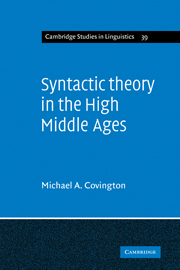Book contents
- Frontmatter
- Contents
- SOLI DEO GLORIA
- Preface
- 1 Introduction
- 2 Before the Modistae
- 3 Modistic grammar
- 4 Syntactic structure
- 5 Modistic treatments of particular syntactic problems
- 6 Subsequent developments
- Appendix: Notes on certain questions of authorship
- Notes
- Bibliography
- Index of names
- Index of topics
- Index of Greek terms
2 - Before the Modistae
Published online by Cambridge University Press: 04 August 2010
- Frontmatter
- Contents
- SOLI DEO GLORIA
- Preface
- 1 Introduction
- 2 Before the Modistae
- 3 Modistic grammar
- 4 Syntactic structure
- 5 Modistic treatments of particular syntactic problems
- 6 Subsequent developments
- Appendix: Notes on certain questions of authorship
- Notes
- Bibliography
- Index of names
- Index of topics
- Index of Greek terms
Summary
Modistic syntactic theory represents in large part the continued development of earlier ideas. Its background begins with the late Roman grammarians who wrote down descriptions of the classical Latin language for posterity – writers such as Donatus, Charisius, Diomedes, and Servius in the fourth century, Phocas and Pompeius in the fifth, and Priscian in the early sixth. The grammarians of the Carolingian Renaissance, such as Alcuin of York (fl. 781-96), Sedulius Scottus (fl. 848-58), and Remigius of Auxerre (c. 900), made use of the writings of many of their Roman predecessors and kept essentially the same descriptive framework.
By the eleventh or twelfth century, however, the range of Roman grammarians whose works were used in the schools of northern Europe had narrowed to two: Donatus and Priscian. The Ars grammatica of Donatus – the first part of which, the Ars minor, is phrased in a catechism-like question-and-answer format – says nothing significant about syntax. The only substantial Roman source for medieval syntactic theory is therefore Priscian, whose eighteen-book Institutiones grammaticae constitute the most voluminous, most thorough, and most disorganized of the surviving Roman grammars. The first sixteen books, referred to in the Middle Ages as Priscianus maior, discuss the individual parts of speech, and the last two (Priscianus minor) are explicitly devoted to syntax, though syntactic information is scattered through the other books as well.
Information
- Type
- Chapter
- Information
- Syntactic Theory in the High Middle AgesModistic Models of Sentence Structure, pp. 4 - 21Publisher: Cambridge University PressPrint publication year: 1984
